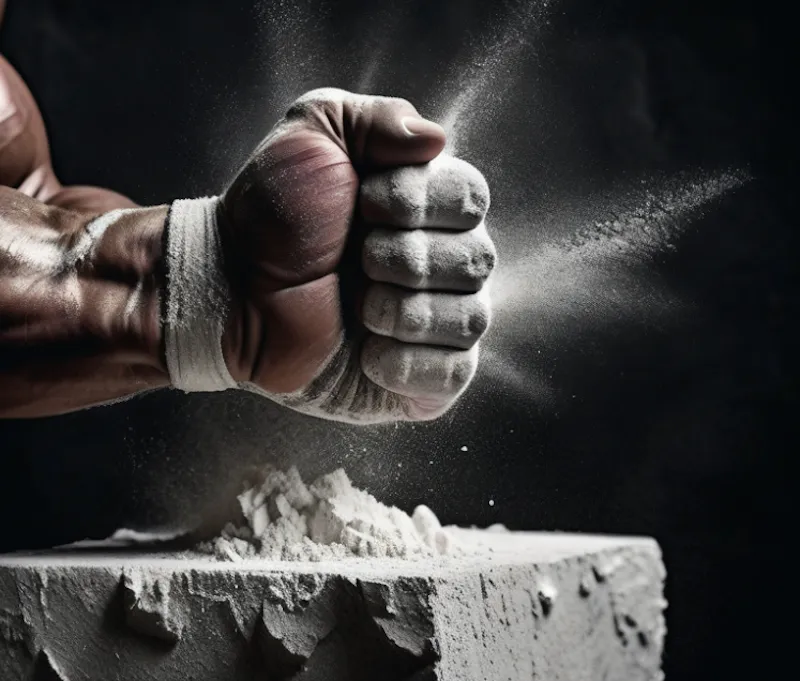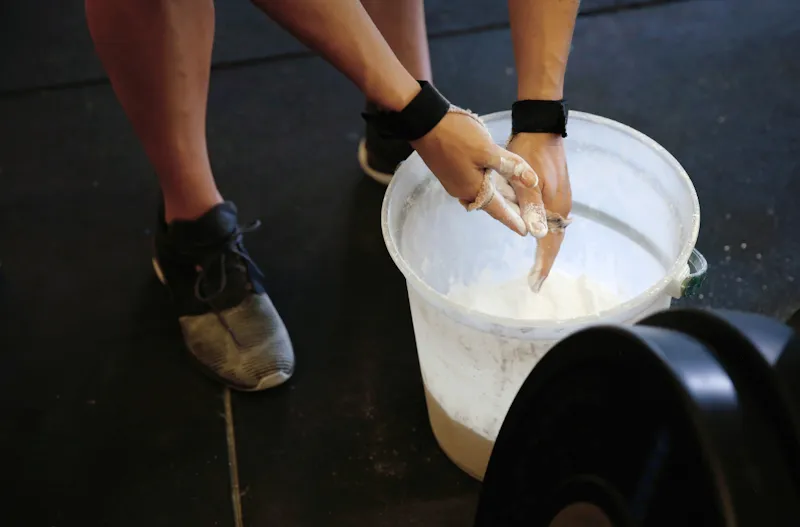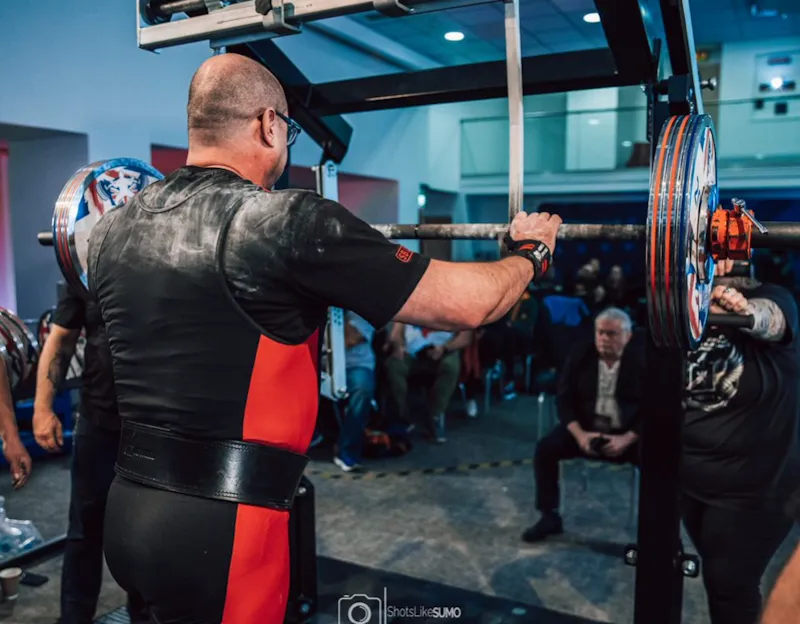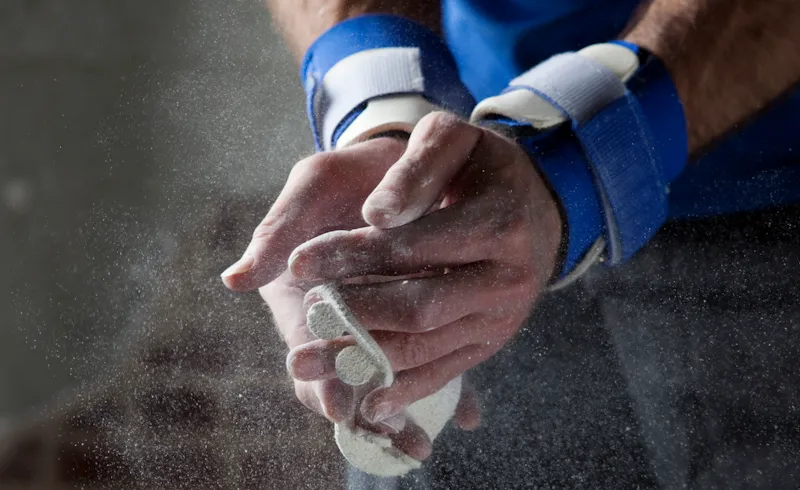Choosing the Right Powerlifting Chalk Type

""
What's In This Article
- Key Highlights
- Introduction
- Powerlifting Chalk and Its Importance
- Comparing Magnesium Chalk Types: Liquid vs. Block vs. Powder
- Health and Safety Considerations When Using Lifting Chalk
- Cost Analysis: Finding Value in Your Chalk Selection
- How to Apply Chalk for Maximum Effectiveness
- Conclusion
- Frequently Asked Questions
Key Highlights
- The right powerlifting chalk can enhance strength and prevent injuries during training.
- Magnesium carbonate is the main ingredient in lifting chalks, which helps absorb moisture and improve grip.
- There are different types available, including traditional block, liquid, and powder.
- The liquid form offers mess-free application and longer-lasting effects, while block substance is a traditional choice for powerlifters.
- Powder is easy to use and offers versatility in application methods.
- Choosing the right form depends on personal preference and specific training needs.
Introduction
Choosing the right powerlifting chalk is an important decision for any serious lifter. Powerlifting requires a strong grip to handle heavy weights and maximize performance. Specifically magnesium carbonate (not to be confused with calcium carbonate), is used for both climbing and weight training to improve grip strength and prevent injuries during training, especially during heavy deadlifts and weight lifting. However, straps can also support your grip during heavy pulling movements if not available. For the best lifting chalk, consider investing in weightlifting chalk specifically designed for powerlifting, as it provides a stronger and more durable grip for heavy lifting. Additionally, many powerlifters have found that the best chalk for their needs is actually a combination of both magnesium carbonate and calcium carbonate, creating the perfect balance of grip and durability.
The main ingredient is magnesium carbonate. Magnesium carbonate has excellent moisture-absorbing properties and provides a rough texture that enhances grip. When applied to the hands, it forms a layer that helps keep them dry, reduce slippage, and improve overall grip strength.
There are different types available in the market. Traditional block, liquid, and powder are the most common choices. Each type has advantages and considerations, and the choice depends on personal preference and specific training needs.
This blog will explore the different types, their benefits and drawbacks, and how to choose the right type for your powerlifting needs. We will also discuss health and safety considerations when using lifting chalk and answer frequently asked questions about it.
Powerlifting Chalk and Its Importance
Chalk is used by powerlifters, weightlifters, and other strength athletes to improve grip strength and prevent injuries during training. The main ingredient is magnesium carbonate, a white inorganic compound known for its moisture-absorbing properties.
Applying to the hands creates a rough and dry surface that enhances grip strength. This is especially important in powerlifting, where a strong grip is essential for handling heavy weights and maintaining control during reps. It helps reduce slippage and increase friction between the hands and the barbell or other equipment, allowing lifters to maintain a secure grip and lift more weight confidently.
In addition to its grip-enhancing properties, it also acts as a protective layer for the hands. The rough surface created helps to distribute the pressure on the hands more evenly, reducing the risk of blisters, calluses, and other hand injuries that can occur during intense training sessions. This is especially important for those with sweaty palms, as it helps to maintain hygiene and prevent the spread of bacteria and viruses in the gym.
Enhancing Grip and Performance
One key benefit is its ability to enhance grip strength. Grip strength is crucial in powerlifting, as it allows lifters to maintain control of the barbell and execute lifts with precision and stability. A good grip ensures that the barbell or other equipment does not slip or move during lifting, which can lead to injuries or compromised performance.
When powerlifting it is applied to the hands, it improves grip by increasing friction between the hands and the barbell. The dry and rough texture of dry chalk, such as Primo Chalk, enhanced with the addition of essential oils, creates more surface area for the hands to grip, ensuring a strong and secure hold even for those with sweaty hands. This enhanced grip, also known as a really good grip, not only enhances performance for top athletes, but also reduces the risk of accidents or mishaps during lifts, making Friction Labs Premium Sports Chalk, made in the USA, an essential tool for any powerlifter looking to enhance their grip and overall performance.
Applying chalk to the hands becomes a ritual or cue for lifters, signaling they are ready to lift and giving them confidence and focus. This mental boost can improve performance and make lifting sessions more successful, particularly for Olympic lifters who rely heavily on grip strength. Additionally, a layer of chalk can prevent blisters and tears that form when performing fast, repetitive motions, such as kettlebell swings and cleans.
Different Scenarios Where Chalk Can Make a Difference
Powerlifting chalk is beneficial for powerlifters and athletes in other sports that require a strong grip.
- Powerlifting: Powerlifters rely on a strong grip to handle heavy weights during squats, bench presses, and deadlifts. A strong grip helps improve grip strength and reduce slippage, allowing powerlifters to lift more weight with confidence and control.
- Weightlifting: Weightlifters also benefit from using chalk during Olympic lifts, such as the snatch and clean and jerk. These lifts require a secure grip on the barbell, which helps enhance grip strength and prevent the barbell from slipping during explosive movements.
- Rock Climbing: Rock climbers use it to keep their hands dry and improve grip while scaling challenging terrains. It provides an extra layer of friction between the hands and the rocks, helping climbers to maintain a secure hold and prevent accidents.
- Gymnastics: Gymnasts often use it to enhance their grip on the bars, rings, and other equipment. It improves grip strength and reduces slippage, allowing gymnasts to perform complex manoeuvres with confidence and control.

Comparing Magnesium Chalk Types: Liquid vs. Block vs. Powder
There are three types : liquid, block, and powder. Each type has its own advantages and considerations.
Liquid is a popular choice among lifters because it offers mess-free application and longer-lasting effects. Block, on the other hand, is a traditional choice for powerlifters and offers excellent grip and longevity. Powder is versatile in application methods and easy to use, making it a popular choice among lifters, but it also comes with the downside of chalk dust. However, if you want a cleaner and more convenient option, you may want to consider using regular chalk, in liquid form for ease of application. Another option to consider is liquid grip, which combines the benefits of liquid chalk with added grip and durability. For those looking for a larger quantity, a large bottle of liquid chalk may be the best option, providing good value at $24. Spider chalk, made in the USA, is another great option for those looking for a strong grip during powerlifting, whether in a traditional gym or a crossfit gym setup. The unique formula of spider chalk provides a strong and long-lasting grip, making it a popular choice among lifters. However, for those who prefer a cleaner and less messy option, liquid chalk such as Secret Stuff® is a great alternative to loose chalk. Its isopropyl alcohol base ensures a strong grip without the chalk dust and mess associated with traditional chalk. The choice of type ultimately depends on personal preference and specific training needs, but it's important to note that many options on the market are actually shipped from China, making Spider Chalk's USA-made option a standout choice for those looking to support American businesses.
Liquid Chalk: Pros, Cons, and Best Use Cases
A modern twist on the traditional, combining magnesium carbonate with alcohol to create a quick-drying paste. Here are some pros, cons, and best use cases for liquid:
Pros:
- Mess-free application: Liquid dries quickly and leaves no residue, making it easy to use without creating a mess.
- Longer-lasting effects: Liquid tends to stay on the hands for a longer period of time compared to other types, providing a more consistent grip during training.
- Antibacterial properties: The alcohol content in liquid has antibacterial properties, which can help reduce the risk of infections.
Cons:
- Higher cost: Generally more expensive than other types due to its added convenience and benefits.
- Drying effect: It can dry out the skin more than other types, which may concern individuals with dry or sensitive skin.
Best Use Cases:
- Powerlifting: Especially beneficial for powerlifters who require a strong and long-lasting grip on the barbell during heavy lifts.
- Gymnastics: Gymnasts can benefit from the mess-free and longer-lasting effects, as it provides a secure grip on the bars and other equipment.
- Commercial gyms: This is a convenient option for lifters who train in gyms with restrictions on traditional chalk, as it is less noticeable and easier to clean up.
Block Chalk: Traditional Choice for Powerlifters
Block is the traditional choice for powerlifters and has been used for decades. Here are some pros, cons, and best use cases for blocks:
Pros:
- Excellent grip: Provides a strong and secure grip on the barbell, enhancing grip strength and reducing slippage during lifts.
- Longevity: This lasts a long time and can be shared among multiple lifters, making it a cost-effective choice for powerlifting gyms.
- Versatility: It can be broken down into smaller chunks or ground into a fine powder, allowing for flexible application methods.
Cons:
- Messy: Can create dust clouds and leave residue on the floor and equipment, requiring additional clean-up.
- Inconvenient for travel: Transport can be bulky and messy, making it less suitable for athletes who train in different locations.
Best Use Cases:
Powerlifting competitions: It is commonly used in powerlifting competitions, as it provides a reliable and effective grip on the barbell.
- Home gyms: This is a convenient option for lifters who train in their own home gyms, as they can easily store and use them without restrictions.
Powder Chalk: Ease of Use and Application Methods
Powder is another popular choice among powerlifters and offers ease of use and versatility in application methods. Here are some pros, cons, and best use cases:
Pros:
- Easy to use: It can be applied directly to the hands, making it a convenient option for lifters.
- Versatile application methods: Can be applied in different ways, depending on personal preference and specific training needs.
- Cost-effective: Generally more affordable than liquid and can last a long time, making it a cost-effective choice for powerlifters.
Cons:
- Dusty: Can create dust clouds and leave residue on the floor and equipment, requiring additional clean-up.
- Less convenient for travel: Can be messy to transport and may require additional containers or storage solutions.
Best Use Cases:
- Powerlifting training: Versatile option for powerlifters, as it allows for easy application and can be used in various training scenarios.
- Home gyms: Convenient choice for lifters who train in their own home gyms, as they can easily store and use without restrictions.
Health and Safety Considerations When Using Lifting Chalk
While it offers numerous benefits for grip strength and performance, it is important to consider health and safety considerations when using it. Here are some key factors to keep in mind:
- Potential skin reactions: Some individuals may experience skin reactions or irritation when using it. It is important to monitor any changes in the skin and discontinue use if any adverse reactions occur.
- Respiratory health: When applied or disturbed, it can create dust clouds, which can be inhaled and potentially irritate the respiratory system. It is recommended to use it in a well-ventilated area and minimize dust inhalation.
Potential Skin Reactions and How to Mitigate Them
Generally safe to use, some individuals may experience skin reactions or irritation when using it. This can be due to the drying effects or individual sensitivity to the ingredients. Here are some tips to mitigate potential skin reactions:
- Apply a protective layer: Before applying, consider a thin layer of moisturizer or lotion to create a barrier between the skin.
- Monitor skin reactions: Pay attention to any changes in the skin, such as redness, itching, or rash. If any adverse reactions occur, discontinue use and consult a dermatologist if necessary.
- Choose a high-quality product: Opt for products made from high-quality ingredients, such as pure magnesium carbonate. Cheaper products may contain additives or impurities that can increase the risk of skin reactions.
Respiratory Health and Minimizing Inhalation
When applied or disturbed, it can create dust clouds, which can be inhaled and potentially irritate the respiratory system. Here are some tips to minimize inhalation and promote respiratory health:
- Use in a well-ventilated area: Ensure that the training area has proper airflow to minimize dust concentration.
- Avoid excessive use and disturbance: Use sparingly and avoid excessive shaking or disturbance to minimize the release of particles.
- Consider wearing a mask: If you are particularly sensitive to dust or have existing respiratory conditions, you should consider wearing a mask or respirator during training sessions.

Cost Analysis: Finding Value in Your Chalk Selection
It is important to consider the cost and value of the product. Here are some factors to consider when analyzing the cost:
Price comparison between types: Compare the prices of different products, such as liquid, block, and powder, to determine the most cost-effective option.
Longevity and mileage: Consider how long each type lasts and how far it can be used. This can help determine the overall value and cost-effectiveness of the product.
By considering the cost and value , lifters can make an informed decision and find the best option that suits their budget and training needs.
Price Comparison Between Chalk Types
When comparing the prices of different powerlifting types, it is important to consider the cost per ounce or gram to determine the most cost-effective option. Here is a price comparison between liquid, block and powder :
Type
Price (per ounce/gram)
Liquid
$1.50 - $2.50 per ounce
Block
$0.50 - $1.50 per ounce
Powder
$0.50 - $1.00 per ounce
These prices may vary depending on the brand and the quantity purchased. It is important to consider the price in relation to the longevity and mileage of each types to determine the overall value and cost-effectiveness.
Longevity and Mileage: Which Type Offers More Bang for Your Buck?
In terms of durability and cost-effectiveness, block is a top choice for lifters seeking longevity and value for money. This type is renowned for its ability to last a long time and be shared among multiple users, with each block typically containing 8 2-oz blocks. If you want to make a smart purchase, a 1-lb box of block should be at the top of your list as it contains no unnecessary fillers or binders, making for a solid primo chalk that helps absorb moisture and improve grip. When assessing the durability and cost-effectiveness of different types, it's important to consider factors such as the solid composition of the block of chalk that can withstand regular use without quickly deteriorating, as well as its suitability for sharing among multiple lifters in gym, garage gym, or training facility settings, making it a must-have for any gym bag. By carefully evaluating the longevity and value of different types, such as block of chalk, gym and refillable chalk balls, lifters can make well-informed decisions to maximize their investment.

How to Apply Chalk for Maximum Effectiveness
Applying correctly is essential for maximum effectiveness. Here are some tips on how to apply for the best results:
- Start with clean, dry hands: Wash and dry your hands thoroughly before applying to ensure maximum effectiveness.
- Apply a thin, even layer: Use a block, liquid, or powder to apply a thin, even layer to your hands, focusing on areas where grip is most important.
- Rub the it into your hands: After applying , rub your hands together to distribute it evenly and ensure full coverage.
Techniques for Applying Liquid Chalk
Liquid chalk requires a slightly different technique for application compared to other types. Here are some techniques for applying effectively:
- Squeeze a small amount onto your palms: Start with a small amount, as a little goes a long way.
- Rub your hands together: Rub your hands together to distribute evenly and ensure full coverage.
- Allow to dry: After applying, wait for it to dry completely. Depending on the brand and the amount applied, this usually takes a few minutes.
Tips for Using Block and Powder Chalk Efficiently
Block and powder variations can be used efficiently with a few tips and tricks. Here are some tips for using these types effectively:
- Break down the block into smaller pieces or grind it into a fine powder for easier and more precise application.
- Use a ball for powder: Place powder in a ball or a mesh bag for controlled and mess-free application.
- Tap off excess: After applying either type, tap off any excess to prevent unnecessary mess and waste.
Conclusion
In conclusion, selecting the right powerlifting chalk type is crucial for enhancing your grip and overall performance. Understanding the differences between liquid, block, and powder can help you make an informed decision based on your preferences and needs. Prioritizing health and safety considerations #, such as mitigating skin reactions and minimizing inhalation risks, is paramount. Cost analysis and application techniques play significant roles in optimizing the effectiveness of the chosen type. By considering these factors thoughtfully, you can elevate your powerlifting experience and achieve better results with the appropriate selection.
Frequently Asked Questions
How often should I reapply chalk during a session?
The frequency of chalk reapplying during a training session depends on factors such as sweat production and grip strength. As a general guideline, it is recommended to reapply chalk whenever the grip feels unsteady, or the hands become sweaty.
Is there a significant difference in performance between chalk types?
The performance difference between chalk types is subjective and depends on individual preference and grip strength. Each chalk type offers its own advantages and considerations, and the choice ultimately depends on what works best for the lifter.
Can using too much chalk have negative effects?
Using too much chalk can create excessive dust clouds and leaves residue on the floor and equipment, increasing the risk of slips and falls. It is important to use chalk in moderation and clean up any excess chalk to prevent injuries.
What's the best way to clean off chalk after use?
To clean off chalk after use, thoroughly wash your hands with soap and water. If any chalk residue remains on the equipment or floor, wipe it off with a damp cloth or use a vacuum cleaner for larger areas.

